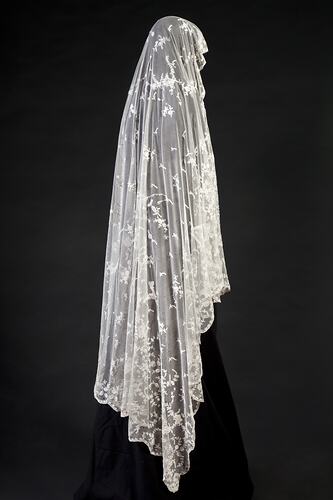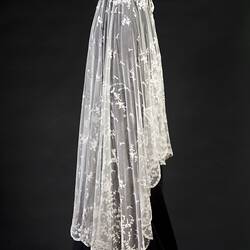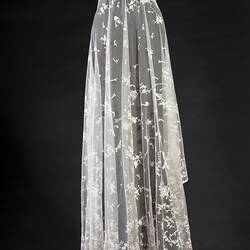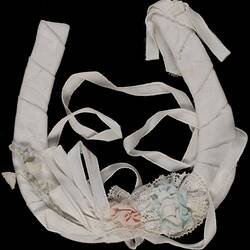Summary
Limerick lace wedding veil imported from Ireland and worn by Janet Scrimgeour at her wedding in Bendigo in 1865 to Peter Brackelmann. She had migrated with her family from Scotland in 1854. For over 130 years this veil, which came to Australia as a result of the migration experience, was passed down the one female line, with the keeper of the veil in each generation then loaning it to every young woman linked to the family to wear at her wedding.
The lace takes its name from its place of origin in Limerick, Ireland. The style first became popular in the mid 19th century and is still made today, often incorporating two well known lace-making techniques; the needlerun stitch and the tambour and hook.
Physical Description
Wedding veil, netting with Limerick lace floral work and scalloped edging.
Significance
The wedding veil represents a wonderful story of a familiar ritualistic female object which connects generations of women in one family across time. For over 130 years this object was passed down the one female line, with the keeper of the veil in each generation then loaning it to every young woman linked to the family to wear at her wedding, thereby keeping the tradition alive. The changing styles and fashions of bridal wear is evident from the earliest photograph of a wearer, the donor's mother Vera Myrtle in 1914 (unfortunately there is no photograph of the first wearer Janet Scrimgeour wearing the veil), through to the donor herself in 1934, her sisters through the 1940s and early 1950s and her own daughter in 1958 - but the veil remains the constant.
More Information
-
Collecting Areas
Migration & Cultural Diversity, Clothing & Textiles, Home & Community
-
Acquisition Information
Donation from Mrs Nancy Maslen, 27 Aug 2003
-
Place & Date Made
-
User
-
User
Mrs Nancy Maslen, Victoria, Australia, 1934-1958
Nancy was the 100th bride to wear the veil and became the final keeper of this precious family heirloom -
Classification
-
Category
-
Discipline
-
Type of item
-
Overall Dimensions
1730 mm (Length), 1440 mm (Width)
-
References
Copies of family trees, marriage certificates, biographical notes from the donor's daughter, family and wedding photographs
-
Keywords
Families, Immigration, Rituals, Scottish Immigration, Wedding Costumes, Weddings




